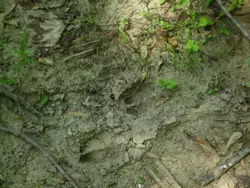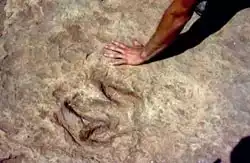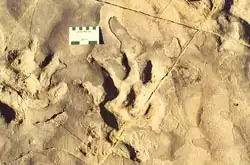Tracks and Trails
When any living being passes over soft sediment, it will leave an imprint of its passage - the footprints of a tiger, tail drags of a crocodile or pointed depressions from a crab's legs. These impressions often are filled in with sediment and preserved as trace fossils. A trace fossil is indirect record of an organism having once existed. It is not a bone or tissue of the once-living being, but an artifact of the organism's life on earth. One particular type of trace fossil, a footprint, can readily show which way is up by seeing in which way the bottom of the foot is relative to the top of the foot in the impression.
Two sides to every story
Depending on how you view the preserved track, it will have a relief that is either negative (denting into the rock) or positive (sticking out of the rock). If the track has negative relief, it is said to be a mold of the print. Stratigraphic up will be the top of the mold and it will be older towards the base of the print, such as is shown in the photographs of dinosaur prints below. If the track has positive relief, it is said to be a cast of the print. Stratigraphic up will be the top of the cast and it will be younger towards the base. For example, in the photograph of cat prints shown to the right, we are looking at the older part of the bed and the stratigraphically younger part is away from you, into the photo.
Click to seen enlarged view outlining print.
Click to seen enlarged view outlining print.
en Espanol Spanish version - tracks (Microsoft Word 29kB Feb2 09)





